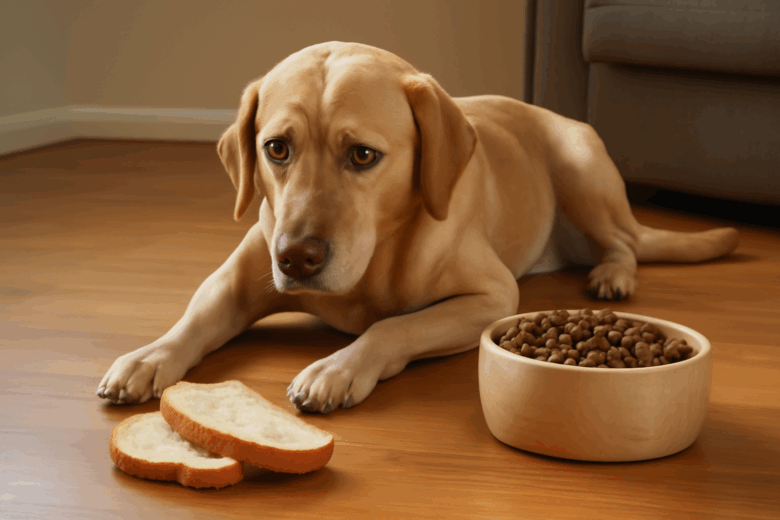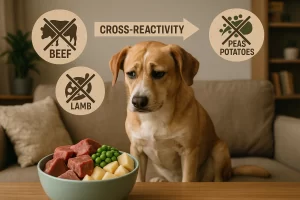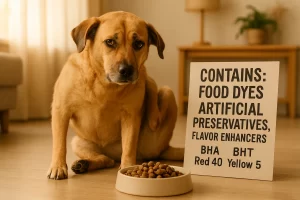As pet owners, we always want the best for our dogs, ensuring their health and happiness. Sometimes, however, our dogs might develop allergies, which can be difficult to detect and manage. One common yet often overlooked allergy is a gluten sensitivity or allergy. In this article, we’ll explore how to recognize the signs of gluten allergy in dogs and discuss safe alternatives to help manage their condition.
Understanding Gluten Allergy in Dogs
Gluten is a protein found in wheat, barley, and rye. While humans are more commonly affected by gluten intolerance or celiac disease, dogs can also develop sensitivities or allergies to gluten. Unlike humans, who may experience severe digestive symptoms from gluten, dogs with gluten allergies may display a variety of symptoms that are harder to identify, making it crucial for pet owners to be vigilant.
A gluten allergy occurs when a dog’s immune system incorrectly identifies gluten as a harmful substance, causing an immune response. This response can lead to inflammation, digestive issues, skin problems, and other symptoms that can severely affect your dog’s well-being.
Signs of Gluten Allergy in Dogs
Identifying a gluten allergy in your dog can be tricky, as the symptoms often resemble other conditions or allergies. Here are the most common signs to watch out for:
1. Digestive Issues
One of the primary indicators of a gluten allergy in dogs is gastrointestinal distress. Symptoms may include:
- Diarrhea
- Vomiting
- Gas or bloating
- Constipation
- Weight loss or poor weight gain
These digestive issues occur because gluten can irritate the intestines, making it difficult for your dog to properly digest food.
2. Skin Irritations
Another common symptom of gluten intolerance in dogs is skin problems. Dogs with gluten allergies may develop:
- Itchy skin or hotspots
- Red, inflamed patches
- Hair loss
- Chronic ear infections
These skin issues arise as a result of the body’s immune system reacting to gluten as an irritant. The inflammation caused by the allergic reaction can lead to itchy skin and other discomforts.
3. Behavioral Changes
Some dogs with gluten allergies may exhibit subtle behavioral changes. These may include:
- Lethargy or fatigue
- Irritability
- Licking or chewing paws excessively
- Increased thirst
While these signs may not directly relate to gluten, they can indicate that your dog is not feeling well and is struggling with discomfort.
4. Inflammation and Joint Pain
Chronic inflammation caused by a gluten allergy may lead to joint pain and stiffness. If your dog suddenly has difficulty walking or shows signs of pain, it could be related to the inflammation caused by their gluten intolerance.
Diagnosing a Gluten Allergy in Dogs
If you notice any of these symptoms in your dog, it’s important to consult with your veterinarian. Diagnosing a gluten allergy typically involves a combination of methods, including:
- Elimination diet: The vet may recommend switching your dog to a gluten-free diet for several weeks to see if their symptoms improve. If the symptoms subside and then return when gluten is reintroduced, it may confirm the allergy.
- Blood tests or skin tests: While these tests are more commonly used to diagnose other allergies, they may help rule out or confirm a gluten sensitivity.
It’s crucial to work closely with your vet to ensure an accurate diagnosis and effective treatment plan for your dog’s health.
Safe Alternatives for Dogs with Gluten Allergies
Once your dog is diagnosed with a gluten allergy, it’s essential to change their diet to avoid any harmful effects. Fortunately, there are plenty of safe and healthy alternatives to traditional dog food that contains gluten.
1. Grain-Free Dog Food
Many commercial dog foods are now available that are completely grain-free, making them an excellent option for dogs with gluten allergies. These foods typically contain protein-rich ingredients like chicken, lamb, or fish, along with vegetables like sweet potatoes or peas as a source of carbohydrates.
2. Home-Cooked Meals
Another alternative is preparing home-cooked meals for your dog. If you’re considering making your dog’s food from scratch, it’s important to work with your veterinarian to create a balanced, gluten-free diet. Home-cooked meals can include lean meats, vegetables, and gluten-free grains like quinoa or rice. Make sure to avoid any foods that are toxic to dogs, such as onions, garlic, and grapes.
3. Raw Diet (BARF Diet)
The raw or BARF (Biologically Appropriate Raw Food) diet is a controversial but increasingly popular approach to dog nutrition. This diet consists mainly of raw meat, bones, fruits, and vegetables. It eliminates all gluten-containing ingredients by nature, though it’s essential to ensure that your dog’s raw food is nutritionally balanced. Consult a professional before starting this type of diet.
4. Gluten-Free Dog Treats
Along with regular food, it’s essential to offer gluten-free treats to your dog. Fortunately, many pet stores offer gluten-free dog treats made from natural ingredients. These treats can be made with alternative flours, such as rice flour or coconut flour, to ensure your dog’s health is maintained without exposure to gluten.
5. Supplements
If your dog’s diet lacks certain nutrients due to the removal of gluten, consider adding supplements. Omega-3 fatty acids, probiotics, and vitamins can help maintain your dog’s overall health and support their digestive system. Always consult with your vet before adding supplements to your dog’s diet to ensure they’re safe and necessary.
Conclusion
If you suspect your dog may have a gluten allergy, it’s important to pay attention to the signs and consult your veterinarian for proper diagnosis and treatment. With the right care, your dog can live a happy, healthy life without gluten-related discomfort. By switching to a gluten-free diet and providing appropriate alternatives, you can help your dog feel their best and ensure they stay healthy for years to come.



